
Friday, December 14, 2012
Review of The Emerald Forge by Manda Benson

Tuesday, May 1, 2012
Review of Becoming a Boy by Will Robertson
Sunday, April 22, 2012
Book recommendation: The Dodo Dragon and Other Stories
My friend, Sheila Crosby, has just released an e-book, The Dodo Dragon and Other Stories. It's available from Amazon.com's Kindle Store (http://www.amazon.com/s/ref=nb_sb_noss?url=search-alias%3Ddigital-text&field-keywords=dodo+dragon) as well as from Dragon Tree Publishing (http://dragontree.sheilacrosby.com/blog/the-dodo-dragon-and-other-stories/) in epub, Kindle, and PDF formats.
http://starisland.co.uk - A Breathtaking Window on the Universe
http://sheilacrosby.com - The Write Site
Saturday, February 11, 2012
Review of Fallstaff’s Big Gamble by Hank Quense
Shakespeare is probably rolling over in his grave laughing. Quense “borrows” three of the bard’s best-known characters and sets them down in his mythical Gunderland. The denizens of this land are mostly trolls, elves, dwarves, half-pints (think Hobbits) and yuks, but they display all our basic human foibles: short-sighted, gullible, cunning, clueless, avaricious, self-serving … As is typical of Quense’s characters, they all are afflicted with a bad case of tunnel vision, lying to themselves as well as others and incapable of seeing the big picture.
Hamlet, the Crown Prince of Denmarko, is torn between avenging his father’s murder and following his chosen profession of beekeeping. Colonel Othello discovers that being in charge of Homeland Security for the city of Dun Hythe is fraught with complications—but those pale before the discovery that he owes his appointment to his wife’s grandmother, who is The Godmother, the local crime boss. And then there’s that fascinating rogue, the con artist Falstaff.
Any one of these would provide an intriguing story, but Quense stirs them all together to come up with a convoluted plot that could only take place in Gunderland. Schemes and counter schemes, bravery and treachery, battles on land and sea, true love…what’s not to like?
http://strangeworldsonline.com/books-main.html for more details: scheduled for release in April, 2012

